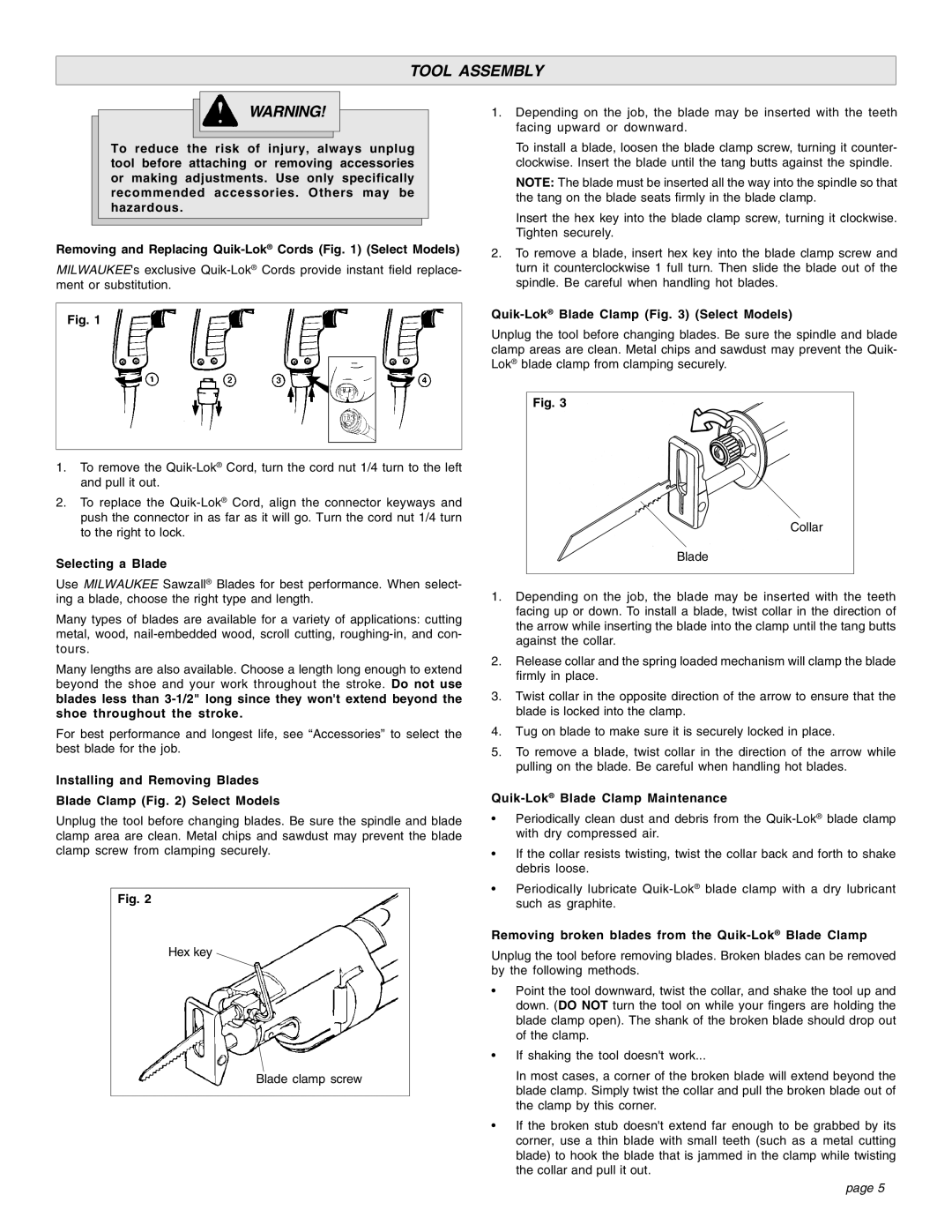
TOOL ASSEMBLY
WARNING!
To reduce the risk of injury, always unplug tool before attaching or removing accessories or making adjustments. Use only specifically recommended accessories. Others may be hazardous.
1.Depending on the job, the blade may be inserted with the teeth facing upward or downward.
To install a blade, loosen the blade clamp screw, turning it counter- clockwise. Insert the blade until the tang butts against the spindle.
NOTE: The blade must be inserted all the way into the spindle so that the tang on the blade seats firmly in the blade clamp.
Insert the hex key into the blade clamp screw, turning it clockwise. Tighten securely.
Removing and Replacing Quik-Lok® Cords (Fig. 1) (Select Models)
MILWAUKEE's exclusive
Fig. 1
1.To remove the
2.To replace the
Selecting a Blade
2.To remove a blade, insert hex key into the blade clamp screw and turn it counterclockwise 1 full turn. Then slide the blade out of the spindle. Be careful when handling hot blades.
Quik-Lok® Blade Clamp (Fig. 3) (Select Models)
Unplug the tool before changing blades. Be sure the spindle and blade clamp areas are clean. Metal chips and sawdust may prevent the Quik- Lok® blade clamp from clamping securely.
Fig. 3
Collar
Blade
Use MILWAUKEE Sawzall® Blades for best performance. When select- ing a blade, choose the right type and length.
Many types of blades are available for a variety of applications: cutting metal, wood,
Many lengths are also available. Choose a length long enough to extend beyond the shoe and your work throughout the stroke. Do not use blades less than
For best performance and longest life, see “Accessories” to select the best blade for the job.
Installing and Removing Blades
Blade Clamp (Fig. 2) Select Models
Unplug the tool before changing blades. Be sure the spindle and blade clamp area are clean. Metal chips and sawdust may prevent the blade clamp screw from clamping securely.
Fig. 2
Hex key
Blade clamp screw
1.Depending on the job, the blade may be inserted with the teeth facing up or down. To install a blade, twist collar in the direction of the arrow while inserting the blade into the clamp until the tang butts against the collar.
2.Release collar and the spring loaded mechanism will clamp the blade firmly in place.
3.Twist collar in the opposite direction of the arrow to ensure that the blade is locked into the clamp.
4.Tug on blade to make sure it is securely locked in place.
5.To remove a blade, twist collar in the direction of the arrow while pulling on the blade. Be careful when handling hot blades.
Quik-Lok® Blade Clamp Maintenance
•Periodically clean dust and debris from the
•If the collar resists twisting, twist the collar back and forth to shake debris loose.
•Periodically lubricate
Removing broken blades from the Quik-Lok® Blade Clamp
Unplug the tool before removing blades. Broken blades can be removed by the following methods.
•Point the tool downward, twist the collar, and shake the tool up and down. (DO NOT turn the tool on while your fingers are holding the blade clamp open). The shank of the broken blade should drop out of the clamp.
•If shaking the tool doesn't work...
In most cases, a corner of the broken blade will extend beyond the blade clamp. Simply twist the collar and pull the broken blade out of the clamp by this corner.
•If the broken stub doesn't extend far enough to be grabbed by its corner, use a thin blade with small teeth (such as a metal cutting blade) to hook the blade that is jammed in the clamp while twisting the collar and pull it out.
page 5
